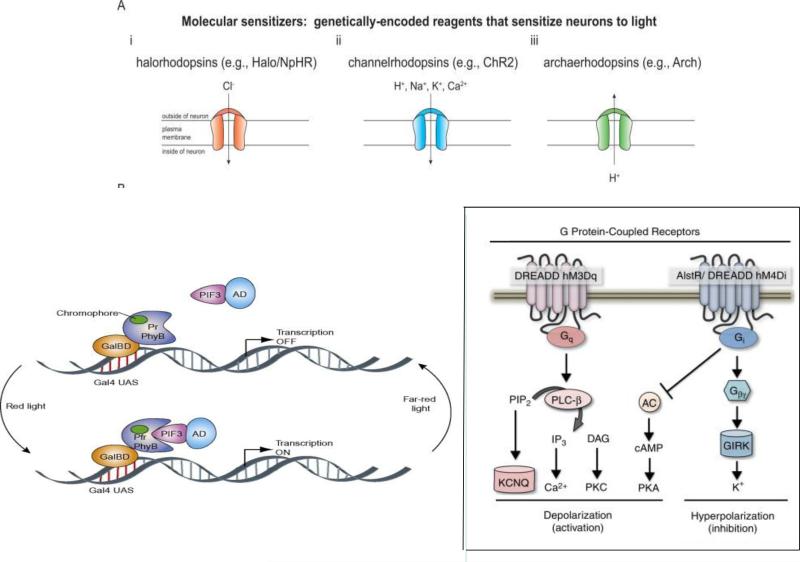Fig. 6.
Genetically encoded biosensors A. Some genetically encoded biosensors have been used as molecular sensitizers to manipulate neuronal activities. Neurons express them can be activated or silenced by light. a. Halorhodopsins, such as N. pharaonis halorhodopsin, pump chloride ions inward and hyperpolarize the neuron upon yellow light. b. Channel rhodopsins are inward nonspecific cation channels for H+, Na+, K+, and Ca2+. They respond to brief, millisecond-timescale pulses of blue light, transporting cations inward and depolarizing neuron. c. Stimulation of Archaerhodopsins (H. sodomense opsin) with yellow or green lights shuts down neuronal activity by hyperpolarizing neurons. Adapted with permission70.
B. Biosensors can be designed to control protein-protein interactions. Here red light triggers PhyB binding of PIF3. Since PhyB is fused to a Gal4-binding domain (GalBD) and PIF3 fused to a Gal4 activation domain (Gal4AD), binding of PhyB to PIF3 in turn dimerizes GalBD with Gal4AD, and initiates gene expression. Remarkably, in the dark or upon far-red light PhyB reverts to the non-binding conformation and releases PIF3, shutting down transcription. In this way, light can be used to either induce or shut down transcription. Adapted with permission from155.
C. Biosensors are effective tools to rapidly manipulate neuronal activity. DREADDs are engineered from muscarinic acetylcholine receptors (mAChRs). It is potently activated by the pharmacologically inert molecule clozapine-N-oxide (CNO). When it is coupled to Gq, Gi or Gs the GPCR signaling pathways can be manipulated without obvious interference with endogenous GPCR signaling. In this figure the presence of CNO selectively activates (Gq-coupled hM3Dq) or inhibits (Gi-coupled hM4Di) G-protein signaling. The response is robust and reversible for the study of neuronal activity. Activation of Gq signaling leads to neuronal depolarization and increased activity. In contrast, CNO activation of Gi signaling triggers inward rectifying potassium channels (GIRKs), resulting in hyperpolarization and inhibition of the neuron.

